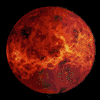|
~
Venus |
||
Venus is the second closest planet to the Sun. Besides Mercury, it is the only planet without a moon. Venus is known as Earth's "twin" because the two planets are so similar in size. Venus' diameter is about 7,520 miles (12,100 km) - that's only about 400 miles smaller than Earth's. The two planets are also similar in mass, density, and rock composition. Venus is the planet that comes closest to the Earth; it comes as close as 25.7 million miles (41.4 million km) from our planet. There isn't any life on Venus, although it is similar to Earth in many ways. This is because it is too hot, too dry, and too poisonous. Venus' atmosphere is mostly made of carbon dioxide, with sulfuric acid, which is a deadly poison, in its upper clouds. The planet's distance from the sun and its atmosphere are the reasons it's so hot. Because of a process known as the "greenhouse effect" the carbon dioxide absorbs and traps the Sun's heat that reaches the surface. Therefore, the heat is not released back into space. Venus is the hottest planet. Its surface temperature is a uniform 900 degrees F (480 C) - that's hotter than a kitchen oven. In fact, Venus' surface is hot enough to melt lead and the planet's rocks can glow because they are so hot. Even though it's hot on the surface, Venus' days aren't filled with sunlight, its dense clouds only allow about 15 percent of the Sun's light to pass through. However, the planet's nights aren't totally dark either because the clouds bend light so it hits its night side. The clouds also cause high surface pressure. Many scientists argue that Venus was subjected to a so-called runaway "greenhouse effect." They say this effect caused any oceans to evaporate into the atmosphere. Unless carbon emissions are reduced on our planet, the same fate may await Earth. Although Venus' atmosphere does not allow for life, its bright yellow clouds look appealing from space. In fact, the planet was so attractive that it was named after the Roman goddess of love and beauty. Venus is the only planet, that when it is near its brightest point, can be seen in daylight; besides the Moon and Sun, it is the brightest object in the sky. At night, it shines more brightly than any other planet or star in the sky. Venus has been called the "evening star" because it looks like the first star of the night. At certain times of the year, the planet can be seen in the east at sunrise. At other times, it can be seen in the west at sunset. Ancient astronomers thought they were seeing two different objects in the sky. They called Venus "Phosphorus" or "Lucifer" when it appeared at sunrise and "Hesperus" when it appeared at sunset. Venus spins so slowly that one day on the planet lasts 8 months on Earth. Once every 243 Earth days, Venus rotates. However, it rotates in the opposite direction to most of the other planets. The same side of Venus faces the Earth every time their orbits pass each other. NASA has sent several space probes to Venus, including Mariner 2 in 1962, Mariner 5 in 1967, and Mariner 10 in 1974. Pioneer Venus and Pioneer Venus 2 were spacecraft sent to the planet. The U.S. Magellan mapped 98 percent of the planet during the first half of the 1990s.
|
||

